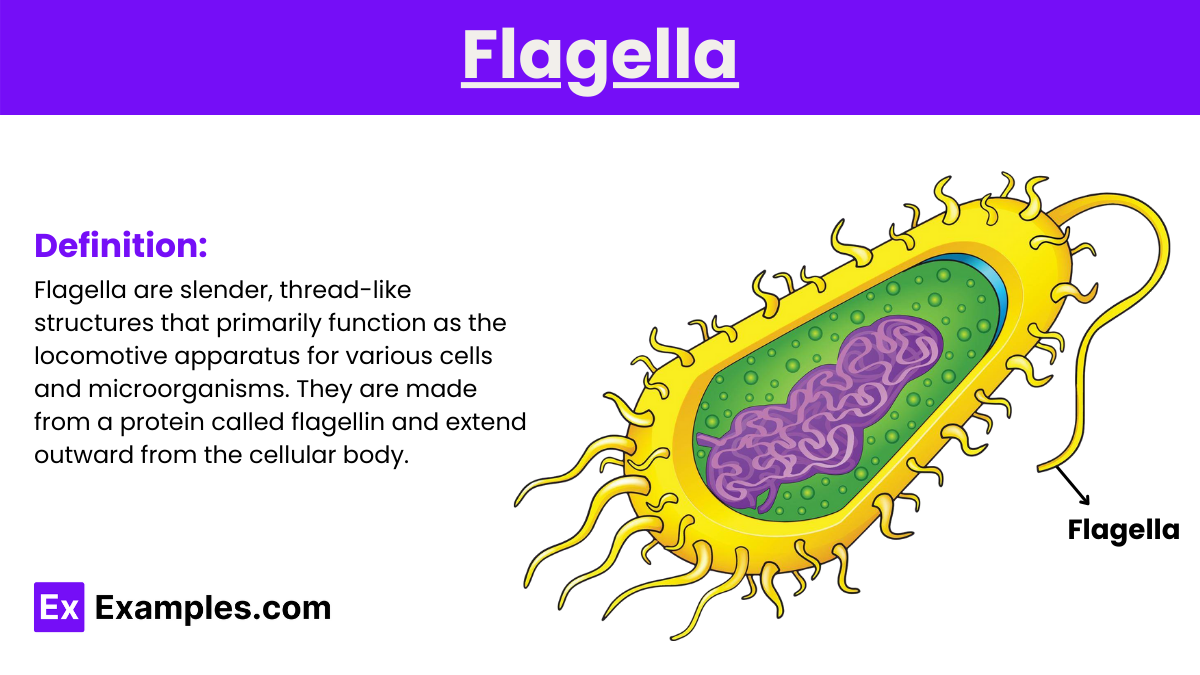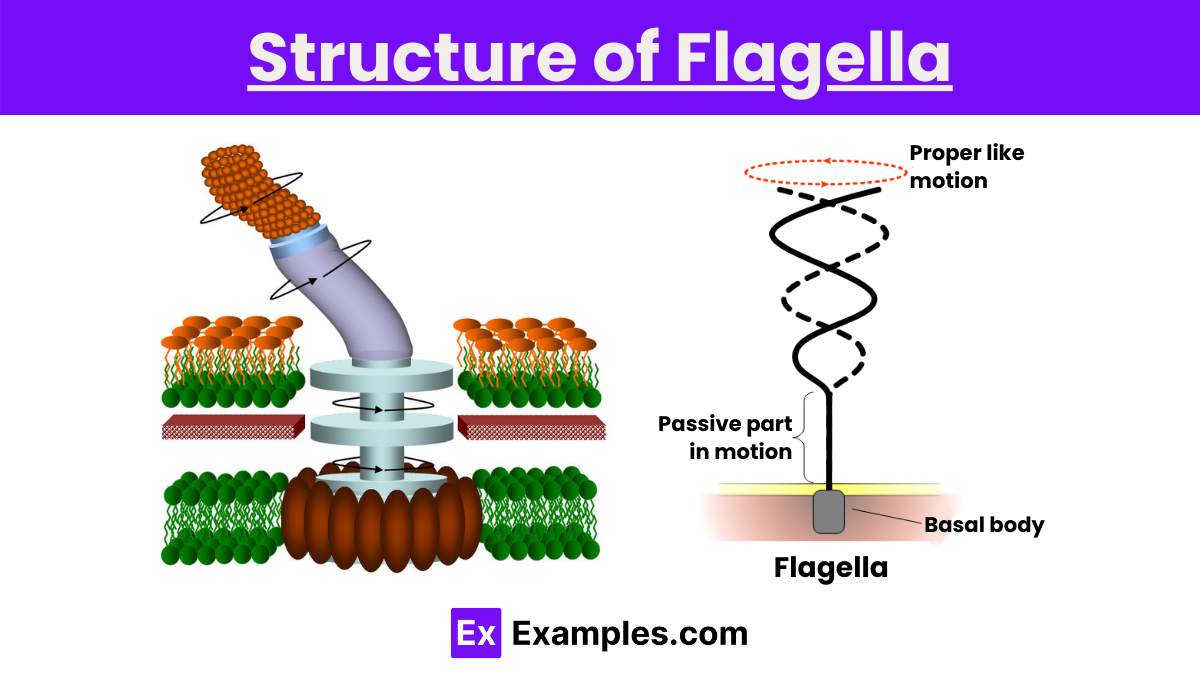What is the primary function of flagella?
Photosynthesis
Movement
Protein synthesis
Reproduction


Flagella are slender, thread-like structures that extend from the cell body of various organisms, including bacteria, archaea, and eukaryotes. These structures play a crucial role in locomotion, allowing cells to move through liquid environments effectively. Structurally, flagella are composed of a protein called flagellin in bacteria and a complex arrangement of microtubules in eukaryotic cells, wrapped in an extension of the cell membrane. The movement of flagella, often described as a whip-like motion, propels the cell forward, navigating and responding to environmental signals. This mobility is essential for processes such as feeding, reproduction, and survival, making flagella a critical component of cellular function and adaptation.
Flagella are slender, thread-like structures that primarily function as the locomotive apparatus for various cells and microorganisms. They are made from a protein called flagellin and extend outward from the cellular body. The presence of flagella is critical in many biological contexts as it enables cells to move through liquid environments. This mobility is essential for the survival and functioning of these organisms, including bacteria, archaea, and certain eukaryotic cells.
Here is a detailed comparison of the three primary types of flagella—bacterial, archaeal, and eukaryotic—in a table format:
| Feature | Bacterial Flagella | Archaeal Flagella (Archaella) | Eukaryotic Flagella |
|---|---|---|---|
| Composition | Composed of the protein flagellin. | Made from proteins that are not homologous to flagellin. | Comprised of a complex of microtubules called the axoneme. |
| Structure | Consists of a basal body, a hook, and a filament. | Simpler, smaller structure similar to type IV pili. | Includes a basal body, axoneme, and is surrounded by plasma membrane. |
| Movement Mechanism | Rotates like a propeller. | Rotates, generally more energy-efficient than bacterial flagella. | Moves in a whip-like or wave-like fashion rather than rotating. |
| Main Functions | Facilitates chemotaxis, moving towards nutrients and away from toxins. | Similar motility function but adapted to extreme environments. | Locomotion, fluid movement, sensory functions, and signal transduction. |
| Typical Length | Several micrometers long. | Typically shorter than bacterial flagella. | Can be up to 200 micrometers in length in some eukaryotes. |
| Energy Use | Uses the proton motive force for energy. | Uses ATP for energy, which is different from bacterial flagella. | Utilizes ATP for movement. |
| Found In | Bacteria | Archaea | A wide range of eukaryotes, including animals and protozoa. |

In bacteria, the flagellum has a relatively simple and well-defined structure, consisting of three main parts:
Archaeal flagella, also known as archaella, share some superficial similarity with their bacterial counterparts but differ significantly in composition and mechanism:
Eukaryotic flagella (often called cilia when short and numerous) are more complex than those in prokaryotes and have a distinct internal structure known as the axoneme:
The most recognized function of flagella is to facilitate movement. Flagella act like propellers, enabling cells to move through liquid environments. This mobility is crucial for various biological processes, including:
Flagella are not only motor structures but also serve as sensory organelles. They contain receptors that detect changes in the chemical composition and temperature of their environment. This sensory capability allows flagella-bearing cells to:
In some bacteria, flagella also play a role in adherence to surfaces and the formation of biofilms. This function is particularly significant in the context of pathogenic bacteria, where flagella:
In certain eukaryotic cells, flagella are involved in the reproductive process. They assist in the movement of gametes, thereby facilitating fertilization. For instance:
1. Initiation of Basal Body Formation: The formation of flagella begins with the basal body. In bacteria like Escherichia coli, this process starts with the assembly of the MS ring in the cytoplasmic membrane, followed by the addition of several other rings (C, P, and L rings) that are crucial for the stability and rotation of the flagellum.
2. Hook and Filament Assembly: Once the basal body is in place, the next step is the construction of the hook. Proteins required for the hook are transported through the hollow core of the basal body and assemble at its tip. After the hook reaches a certain length, a switch in protein export occurs, leading to the assembly of the filament. The filament proteins, primarily flagellin, are similarly transported through the core and begin to polymerize at the tip of the growing flagellum.
3. Completion and Functionality: The final stage involves the completion of the filament and the incorporation of the cap protein at the tip, which is essential for guiding the continued addition of flagellin units. Once fully assembled, the basal body operates as a rotary engine, powered by the proton motive force (or, in some bacteria, the sodium motive force), enabling the flagellum to spin and propel the bacterium through its environment.
A flagellum is a slender, thread-like structure that extends from the cell body of certain organisms, including bacteria, protozoa, and some animal cells. Its primary function is to aid in locomotion, allowing the cell to move through liquid environments. The structure is powered by a motor protein at the base, which rotates the flagellum like a propeller.
Flagella is simply the plural form of flagellum, referring to instances where a cell possesses more than one flagellum. For example, some bacteria species are equipped with multiple flagella that enhance their mobility and enable more complex movements such as tumbling and swarming.
In humans, flagella are specialized structures that are not as widespread as in many microorganisms. The primary example of flagella in the human body is the sperm cell. Here, the flagellum plays a critical role in the reproductive process.
The sperm flagellum is similar in structure to eukaryotic flagella found in other organisms but is uniquely adapted to its function of propulsion to reach and fertilize the egg. The flagellum extends from the sperm cell’s body and is divided into several parts:
Flagella play vital roles across different domains of life:
Flagella-related diseases in humans primarily involve the malfunction of sperm flagella, as it is the main flagellated structure in the human body. Abnormalities in the structure, function, or development of sperm flagella can lead to various reproductive issues, primarily affecting male fertility. Here are some key disorders associated with flagellar dysfunction
While technically related to cilia, which are structurally and functionally similar to flagella, Primary Ciliary Dyskinesia (PCD) is often discussed in the context of flagellar diseases due to the shared underlying mechanisms of motility. PCD is a genetic disorder that affects the cilia lining the respiratory tract, ears, sinuses, and reproductive organs. In the lungs, defective ciliary function leads to poor mucus clearance, resulting in chronic respiratory infections, bronchiectasis, and sinusitis.
A subset of PCD, Kartagener Syndrome is characterized by the triad of situs inversus, chronic sinusitis, and bronchiectasis. In addition to these, males with Kartagener Syndrome often experience infertility due to immotile sperm, as the same genetic defect that affects respiratory cilia also impacts the flagella of sperm cells.
Asthenozoospermia is a condition where sperm motility is impaired, which can be due to defects in the sperm flagellum. This can involve abnormalities in the number, structure, or function of the flagella, preventing effective sperm movement. It is a common cause of male infertility and can result from genetic defects, lifestyle factors, or infections.
Although primarily a condition marked by abnormal sperm morphology, Teratozoospermia can include defects in the flagellar structure. Abnormal flagellar formation can impair the sperm’s ability to swim, which is critical for reaching and fertilizing the egg.
Flagella are whip-like structures enabling cells to move efficiently in liquid environments, crucial for navigation and survival.
A flagellum is a microscopic, thread-like appendage that facilitates locomotion in many microscopic organisms, including bacteria and protozoa.
Many bacteria, like E. coli and Salmonella, utilize flagella for motility, aiding in nutrient location and host invasion.
Flagella are found in various organisms, including bacteria, archaea, and eukaryotic cells like algae and protozoans.
The only human cell with a flagellum is the sperm cell, which uses it to swim towards the egg for fertilization.
Text prompt
Add Tone
10 Examples of Public speaking
20 Examples of Gas lighting
What is the primary function of flagella?
Photosynthesis
Movement
Protein synthesis
Reproduction
Which of the following organisms commonly possess flagella?
Bacteria
Fungi
Plants
Mammals
What is the structure of a bacterial flagellum composed of?
Actin filaments
Microtubules
Flagellin
Keratin
In which type of cells are flagella found?
Eukaryotic cells only
Prokaryotic cells only
Both prokaryotic and eukaryotic cells
Neither prokaryotic nor eukaryotic cells
Which of the following describes the motion of bacterial flagella?
Whip-like motion
Rotational motion
Vibrational motion
Oscillating motion
What is the arrangement of microtubules in a eukaryotic flagellum?
9+2 arrangement
9+0 arrangement
8+1 arrangement
6+2 arrangement
Which part of the bacterial flagellum anchors it to the cell membrane?
Hook
Filament
Basal body
Shaft
How do eukaryotic flagella differ from bacterial flagella in terms of movement?
Eukaryotic flagella rotate while bacterial flagella whip.
Eukaryotic flagella whip while bacterial flagella rotate.
Both use the same type of movement.
Neither move; they are stationary.
Which of the following cells in the human body possesses flagella?
Red blood cells
Neurons
Sperm cells
Muscle cells
The energy for the rotation of bacterial flagella is derived from:
ATP hydrolysis
Light
Proton motive force
Glycolysis
Before you leave, take our quick quiz to enhance your learning!

